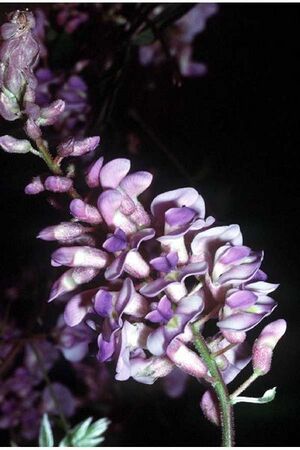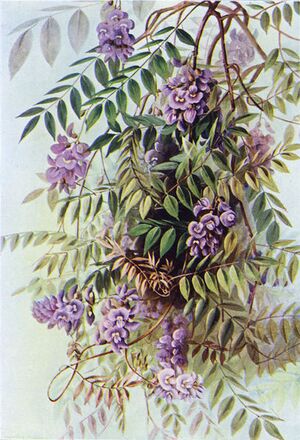American Wisteria
| subsp. var. | ||||||||||||||||||||||||||||||||||||||||||||||||||||||||
|---|---|---|---|---|---|---|---|---|---|---|---|---|---|---|---|---|---|---|---|---|---|---|---|---|---|---|---|---|---|---|---|---|---|---|---|---|---|---|---|---|---|---|---|---|---|---|---|---|---|---|---|---|---|---|---|---|

|
|
| ||||||||||||||||||||||||||||||||||||||||||||||||||||||
| ||||||||||||||||||||||||||||||||||||||||||||||||||||||||
| Standard Cyclopedia of Horticulture |
|---|
|
Wisteria frutescens, Poir. (Glycine frutescens, Linn. Kraunhia frutescens, Greene. Bradleia frutescens, Brit. W. speciosa, Nutt.). Tall stout climber, the trunk attaining several inches in diam.: not glandular, smoothish or somewhat downy at maturity: lfts. 4-6-7 pairs, ovate to ovate-lanceolate, acuminate but obtuse, glabrous above: racemes 4-6 in. long, densely fld.; fls. lilac-purple; auricles of the standard rather prominent; calyx-teeth very short. Low grounds, Va. to Fla. and Texas.—Sometimes planted. Var. alba, Hort., with white fls., has been listed. Var. magnifica, Herincq (W. magnifica, Hort.), supposed to belong here, has racemes 50-60-fld. and 6-8 in. long: fls. 1 in. across, lilac with a yellow spot, earlier than in the type. F.S. 11:1151.
|
| American Wisteria {{{status}}} Fossil range: {{{fossil_range}}}
| ||||||||||||||||||||||||||||||||||||||||||||||||||||||||||||||||||
|---|---|---|---|---|---|---|---|---|---|---|---|---|---|---|---|---|---|---|---|---|---|---|---|---|---|---|---|---|---|---|---|---|---|---|---|---|---|---|---|---|---|---|---|---|---|---|---|---|---|---|---|---|---|---|---|---|---|---|---|---|---|---|---|---|---|---|
 | ||||||||||||||||||||||||||||||||||||||||||||||||||||||||||||||||||
| Plant Info | ||||||||||||||||||||||||||||||||||||||||||||||||||||||||||||||||||
| ||||||||||||||||||||||||||||||||||||||||||||||||||||||||||||||||||
| Scientific classification | ||||||||||||||||||||||||||||||||||||||||||||||||||||||||||||||||||
| ||||||||||||||||||||||||||||||||||||||||||||||||||||||||||||||||||
| [[{{{diversity_link}}}|Diversity]] | ||||||||||||||||||||||||||||||||||||||||||||||||||||||||||||||||||
| {{{diversity}}} | ||||||||||||||||||||||||||||||||||||||||||||||||||||||||||||||||||
| Binomial name | ||||||||||||||||||||||||||||||||||||||||||||||||||||||||||||||||||
| Wisteria frutescens (L.) Poir. | ||||||||||||||||||||||||||||||||||||||||||||||||||||||||||||||||||
| Trinomial name | ||||||||||||||||||||||||||||||||||||||||||||||||||||||||||||||||||
| {{{trinomial}}} | ||||||||||||||||||||||||||||||||||||||||||||||||||||||||||||||||||
| Type Species | ||||||||||||||||||||||||||||||||||||||||||||||||||||||||||||||||||
| {{{type_species}}} | ||||||||||||||||||||||||||||||||||||||||||||||||||||||||||||||||||
| {{{subdivision_ranks}}} | ||||||||||||||||||||||||||||||||||||||||||||||||||||||||||||||||||
| [[Image:{{{range_map}}}|{{{range_map_width}}}|]] | ||||||||||||||||||||||||||||||||||||||||||||||||||||||||||||||||||
| Synonyms | ||||||||||||||||||||||||||||||||||||||||||||||||||||||||||||||||||
| {{{synonyms}}} |
American Wisteria (Wisteria frutescens) is a woody, deciduous, perennial climbing vine of the Wisteria family. It is native to the wet forests and stream banks of the southeastern United States, with a range stretching from the states of Virginia to Louisiana and extending southeast through Florida.
American Wisteria can grow up to 15m long over many supports via powerful clockwise-twining stems. It produces dense clusters of blue-purple, two-lipped, 2-cm-wide flowers on racemes 5-15cm long in late spring to early summer. These are the smallest racemes produced by any member of the Wisteria family. Though it has never been favored in many gardens for this characteristic, many bonsai artists employ American Wisteria for its manageably-sized flowers.
The foliage consists of shiny, dark-green, pinnately compound leaves 10-30cm in length. The leaves bear 9-15 oblong leaflets that are each 2-6 cm long. It also bears numerous poisonous, brown, bean-like seed pods 5-10cm long that mature in summer and persist until winter. American Wisteria prefers moist soils. It is considered shade tolerant, but will flower only when exposed to partial or full sun. It grows best in USDA plant hardiness zones 5-9.
Several characteristics distinguish American Wisteria from its Asian counterparts. It grows only two-thirds as tall, its racemes are half as long (the shortest of the Wisteria family), and its bloom time is sometimes shorter than many Asian varieties. Its flowers are not scented, and its seed pods are smooth rather than velvety. Its most redeeming feature is the fact that it is much less invasive that its Asian counterparts, especially the beautiful but ruthless Chinese Wisteria (Wisteria sinensis). American Wisteria is very similar to Kentucky Wisteria (Wisteria macrostachya).
